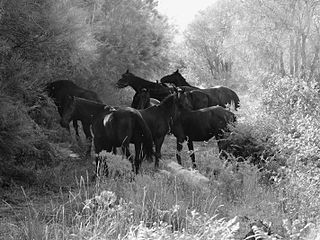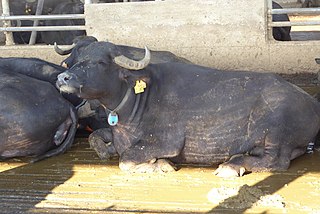
The Italian Heavy Draft, or Rapid Heavy Draft, is a breed of draft horse from Italy. The full Italian name of the breed is Cavallo Agricolo Italiano da Tiro Pesante Rapido, "Italian Rapid Heavy Draft Farm Horse", and the abbreviation TPR ) is often used.

The Sanfratellano or Razza di San Fratello is an Italian breed of riding horse. It originates in the comune of San Fratello, in the Nebrodi Mountains in the province of Messina in north-eastern Sicily. It is one of three Sicilian breeds, the others being the Purosangue Orientale and the Siciliano Indigeno.

The Sardinian Anglo-Arab or Anglo-Arabo Sardo is an Italian breed of riding horse from the Mediterranean island of Sardinia. It derives from cross-breeding of local mares with stallions of Arab, Anglo-Arab and Thoroughbred stock. Breeding began in 1874; the breed was officially recognised in 1967.

The Bardigiano is a traditional Italian breed of small horse. It originates in the region of Emilia Romagna and takes its name from the town of Bardi, in the province of Parma. It is strongly associated with Bardi, the Valle del Ceno and the Val di Taro, and surrounding areas of the Tusco-Emilian Apennines of Parma.

The Neapolitan Horse, Italian: (Cavallo) Napoletano, Neapolitano or Napolitano, is a horse breed that originated in the plains between Naples and Caserta, in the Campania region of Italy, but which may have been bred throughout the Kingdom of Naples. The Neapolitan horse was frequently mentioned in literature from the 16th to the 19th centuries, and is noted for its quality. Corte wrote in 1562: "in Italy the horses of the Kingdom of Naples are greatly esteemed; [there] many fine coursers are born ... suitable for use in war and in the manège and for every service that the rider may require". The decline of the breed was noted in the early 20th century by Mascheroni (1903) and Fogliata (1908). Some sources state that by 1950, the original Neapolitan horse was deemed extinct, but its lines were incorporated into other breeds, most notably the Lipizzaner. An attempt to recreate this breed resulted in the modern breed called Napolitano.
The Siciliano Indigeno or Cavallo Siciliano is an Italian breed of light riding horse native to the Mediterranean island of Sicily in southern Italy. It derives from cross-breeding of local mares with stallions of Oriental and North African type. In the twentieth century there was substantial intromission of Thoroughbred and Anglo-Arab blood, resulting in a marked increase in average height.

The Italian Landrace is an Italian breed of domestic pig. It derives from the Danish Landrace breed developed in Denmark at the end of the nineteenth century. Stock was imported into Italy after the Second World War. The breed has been selected principally for suitability for the production of prosciutto crudo. It is, after the Large White Italiana, the second-most numerous pig breed in Italy. The breed standard is issued by the Ministero delle Politiche Agricole Alimentari e Forestali, the Italian ministry of agriculture and forestry; the herdbook is kept by the Associazione Nazionale Allevatori Suini, the national pig-breeders' association.

The Catria or Cavallo del Catria is an Italian breed of horse. It is named for the massif of Monte Catria in the Marche region of Italy, where it is thought to have originated, and is distributed also in parts of the provinces of Ancona, Perugia and Pesaro. It is one of the fifteen indigenous horse "breeds of limited distribution" recognised by the AIA, the Italian breeders' association.
The Pentro or Cavallo Pentro is an endangered Italian breed of small rustic horse. It originates in the upper valley of the Volturno in the southern Italian region of Molise, close to its borders with Abruzzo, Campania and Lazio, and takes its name from the ancient Samnite tribe of the Pentri, who lived in that area. The population is concentrated in the comune of Montenero Val Cocchiara in the province of Isernia. It is one of the fifteen indigenous horse "breeds of limited distribution" recognised by the AIA, the Italian breeders' association.
The Sarcidano, Italian: Cavallo del Sarcidano, is a rare Italian breed of semi-feral horse originating from the Altopiano del Sarcidano in the comune of Laconi, in Oristano Province of the Mediterranean island of Sardinia. It is one of the fifteen indigenous horse "breeds of limited distribution" recognised by the AIA, the Italian breeders' association.

The Podolica is an Italian breed of domestic cattle. It belongs to the Podolic group of grey cattle. It is raised in the southern Italian regions of Abruzzo, Basilicata, Calabria, Campania, Molise and Puglia. It was formerly distributed throughout most of mainland Italy and as far as Istria, now part of Croatia, and where it is now regarded as a separate breed, the Istrian or Boškarin. The Podolica was in the past bred principally as a draught animal; with the mechanisation of agriculture following the Second World War, demand for draught oxen disappeared, and the Podolica is now raised for meat and – to a lesser extent – for milk.

The Italian Mediterranean buffalo or bufala mediterranea italiana is an Italian breed of water buffalo. It is of the River sub-type of water buffalo and is similar to the buffalo breeds of Hungary, Romania and the Balkan countries. It is the only indigenous water buffalo breed in Italy. A herd-book was opened in 1980, and the breed was officially recognised in 2000.

The Martina Franca donkey, Italian: Asino di Martina Franca, is a breed of donkey from Puglia in southern Italy. It is the largest Italian donkey breed, and was famous for its qualities in the production of mules. It is particularly associated with the comune of Martina Franca from which it takes its name, but the area of origin also includes Alberobello, Ceglie Messapica, Locorotondo, Massafra, Mottola and Noci, in the provinces of Bari, Brindisi and Taranto. It is still raised mainly in Puglia, but there are also populations in Abruzzo, Lazio, Lombardy and Umbria. It is one of the eight autochthonous donkey breeds of limited distribution recognised by the Ministero delle Politiche Agricole Alimentari e Forestali, the Italian ministry of agriculture and forestry.

The Mora Romagnola is a breed of pig from Emilia-Romagna, in northern Italy. It may also be called Mora, Bruna Romagnola, Castagnina or Forlivese. It is raised principally in Emilia–Romagna, but also in Campania, Friuli–Venezia Giulia, Lombardy, the Marche, Piemonte and the Veneto. It is one of the six autochthonous pig breeds recognised by the Ministero delle Politiche Agricole Alimentari e Forestali, the Italian ministry of agriculture and forestry.

The Nero Siciliano is a breed of domestic pig from the Mediterranean island of Sicily, in southern Italy. It is raised mainly in the province of Messina, particularly in the Monti Nebrodi. For this reason it is often known as the Nero dei Nebrodi; it may also be called Nero delle Madonie or Nero dell'Etna, for its association with the Madonie mountains and mount Etna respectively. It is one of the six autochthonous pig breeds recognised by the Ministero delle Politiche Agricole Alimentari e Forestali, the Italian ministry of agriculture and forestry.
The Trimeticcia di Segezia is a modern breed of domestic sheep from Puglia in southern Italy. It is named for the town of Segezia, a frazione of Foggia, where it was created at the Istituto Sperimentale per la Zootecnia, an experimental breeding station of the Ministero delle Politiche Agricole, Alimentari e Forestali, the Italian ministry of agriculture. "Trimeticcia" means "three-way hybrid": the breed was created by cross-breeding Gentile di Puglia ewes with French Île-de-France rams, and then crossing the resultant hybrid with Württemberger rams; the resulting stock was selectively bred for adaptation to the climate and conditions of the area. The range of the breed is principally the plain of the Tavoliere delle Puglie, but extends also into Molise. The Trimeticcia di Segezia is one of the forty-two autochthonous local sheep breeds of limited distribution for which a herd-book is kept by the Associazione Nazionale della Pastorizia, the Italian national association of sheep-breeders.
The Altamurana is an Italian breed of sheep from the province of Bari, in Puglia in southern Italy. It is of Asiatic, possibly Syrian, origin. It is raised mainly in the provinces of Bari and Foggia, and takes its name from the town of Altamura, in the Murge. It was formerly considered a triple-purpose breed, yielding meat, milk, and wool; it is now kept principally for milk production. It yields approximately 65 kg of milk per lactation, with an average of 7.5% fat and 6.5% protein.
The Gentile di Puglia is a breed of domestic sheep indigenous to southern Italy. It originates from the Tavoliere di Foggia, a large plain in the northern part of Puglia, and is raised mainly in that region; a few are found in neighbouring regions. The Gentile di Puglia is sometimes known as the Merinos d'Italia, or Italian merino.
The Apulo-Calabrese is a breed of black domestic pig from Calabria, in southern Italy. It may also be known as the Calabrese, Nero Calabrese or Nero di Calabria, and by many other regional names. It derives from the old Pugliese pig breed of Puglia, which in turn derives from the Casertana breed of Campania; it is closely related to that breed. The Apulo-Calabrese is one of the six autochthonous pig breeds recognised by the Ministero delle Politiche Agricole Alimentari e Forestali, the Italian ministry of agriculture and forestry.

The Sarda or Suino Sardo is a breed of domestic pig from the Mediterranean island of Sardinia, Italy. It is raised mainly in the provinces of Ogliastra and Nuoro, but is also present in those of Medio Campidano and Sassari and in the Sarrabus-Gerrei sub-region. The Sarda breed was officially recognised by ministerial decree on 8 June 2006 and became the sixth autochthonous pig breed recognised by the Ministero delle Politiche Agricole Alimentari e Forestali, the Italian ministry of agriculture and forestry.













